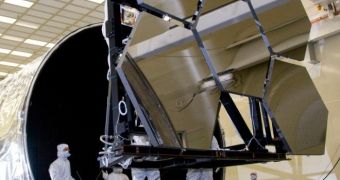Even though the famous Hubble Space Telescope was repaired and upgraded in May 2009, it is clear that the technology on it cannot help the machine keep its dominant position for much longer. NASA is already working on a replacement for it, the massive James Webb Space Telescope, which will truly be a sight to behold when completed. It will be the largest observatory flown to space, and will have the capabilities necessary to conduct surveys of the sky ranging from infrared to ultraviolet. Now, experts in charge of actually constructing the spacecraft announce that they have just finished polishing its first mirror segment, Wired reports.
This is a momentous achievement, given the fact that the margin for error allowed in constructing these mirrors is almost non-existent. New materials and technologies had to be devised specifically for constructing them, and so the fact that one of several mirror segments is completed marks a crucial milestone in the construction phase of the JWST mission. The telescope is currently scheduled to launch in 2014, when it will replace Hubble as the American space agency's main “eye in the sky.” Experts hope that the construction process will finish by then, given the fact that they still have about 18 mirror segments to go before this portion of the spacecraft is completed.
“For validation purposes, we’re planning four sets of completely different cross checks and verification tests to authenticate the outcome of the mirror cryotests. If any discrepancies surface, we can then investigate and re-verify,” explains Northrop Grumman Webb Optical Telescope Element Manager, Scott Texter. Northrop is the main contractor for developing the new mirrors, and it needs to test them within infinitesimally-small margins, before delivering them to NASA. The draconian regulations were set in place to prevent another incident such as the one that took place when Hubble was launched. The telescope got to space with a poorly-polished mirror, which skewed observations until the STS-61 shuttle mission went up there and fixed the problem.
The JWST is to be placed in the L2 Lagrangian point, some 1.5 million kilometers away, beyond the orbit of the Moon, so reaching it would be impossible. Additionally, the shuttle would have long since been retired, so, even if NASA wanted to, it would have no way of reaching the observatory in its seclusion. On the other hand, this vast distance will allow the ultra-sensitive detectors and mirrors on James Webb to detect the rarest photons coming in from extremely distant places in the very young Universe. Data extracted from them could then be used to support existing theories on how it all started, or to develop new ones.

 14 DAY TRIAL //
14 DAY TRIAL //